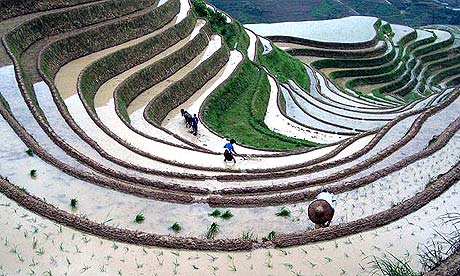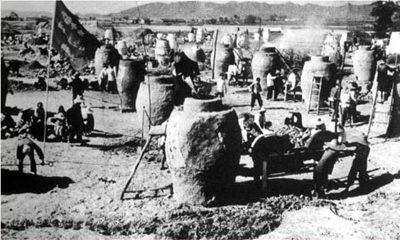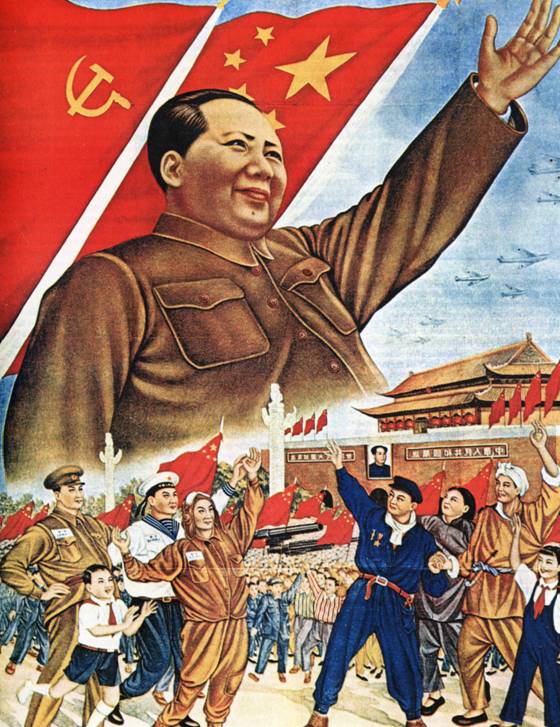
Changes under Mao – II: The Great Leap 1958-62
Summary
In 1958, for reasons which are still debated, Mao decided to push the pace of change much harder, and introduced the 'Great Leap Forward' – an economic revolution based on the peasants.
It was a disaster.
Links:
The following websites will help you complete the task:
The Great Leap: • Photos (sanitised) from the time
• The Great Famine - a personal account
• Chinese posters
• A 5-part BBC documentary (scroll down to the Great Leap)
• History Learning Site
![]()
Features of The Great Leap Forward
a. Lift-off
Mao wanted to ‘overtake the capitalist countries in a short time and become the most advanced, powerful country in the world’
b. Collectivisation
Collectivisation would feed the industrial workers in the towns and produce a cash crop for export
c. The second Five-Year Plan
An ambitious set of industrial targets
d. Blue ants
Mao believed that his targets could be achieved by ‘people’s hearts and minds’, and by mass labour
e. 'Learn from Dazhai'

The construction of the terraces at Dazhai (200 miles south-west of Beijing) was held up as an example to emulate; later it emerged they were built not by peasant labourers, but by soldiers, with state funding
The second Five-Year Plan, 1958-62: facts
a. Industrialisation of the countryside
Industrialisation was to be achieved, not in the towns, but in each commune (e.g. backyard furnaces)
b. Self-sufficient Communes
The commune was supposed to provide its families with all they needed, including hospitals and schools; in some places people handed over all their possessions and went to live in ‘habitation centres’
c. Backyard furnaces

People abandoned the fields and spent days tending home-made furnaces
d. State-owned Enterprises
Private firms and joint state-private enterprises were taken over by the government
e. Targets and lies
State-controlled targets were set, and constantly revised upwards; none of these targets were achieved, but officials constantly claimed they had been exceeded
The second Five-Year Plan, 1958-62: failures
a. Industrial output halved
Output fell – 1958-62 the output of coal fell from 230million tonnes to 180million, the output of light industry fell by 30%, of heavy industry by 65%
b. Quality reduced
Quickly rushed-out goods fell apart
c. Backyard furnaces
The steel produced in the peasant furnaces was simply buried – it was unusable; meanwhile, the peasants had used their pots and tools, and cut down huge swathes of forest to make it (= a personal and an environmental disaster)
d. Rural terror
Terrified officials tried to bully the peasants to produce more. Anybody who tried to carry on with the old ways was a ‘rightist’ and imprisoned. Millions were sent to the Laogai (prison camps)
e. Three Bitter Years, 1959-61
The result was widespread famine which killed perhaps 30 million Chinese
Why did the Great Leap Forward fail?
a. Manpower not investment
Mao’s belief that human willpower alone could bring economic growth was wrong
b. Targets not techniques
There was no planning – simply targets were issued without any advice about how to achieve them
c. Propaganda not statistics
Nobody dared contradict Mao or admit failure. Anyone who questioned success was denounced as a ‘bourgeois reactionary’. There were no accurate inspections and reports – instead officials simply made up ever-bigger lies
d. Drought and floods
The huge Yangzi River dried up in 1960, but that same year there were devastating floods in the south
e. Soviet withdrawal
In 1960, Mao quarrelled with Khrushchev, as a result of which the Soviet experts were recalled – half of China’s Soviet-run industrial plants had to close down
The famine of 1958-62: facts
a. 30 million deaths
i.e. in the 'Three Bitter Years' of 1959-61 (Central China was worst-hit)
b. Tibet
Tibet was particularly badly hit because – as the Panchen Lama discovered in 1962 – the PRC was guilty of intentional genocide, forbidding the Tibetans to grow grain or move their yak herds
c. Martial law, 1962
Fearing mass revolution, the government imposed martial law in 1962
d. Cannibalism
People fought for and stole food. Starving peasants sold, and (it was said) even ate, their children
e. Official denial
Anybody who spoke of famine was declared to a traitor
Task
Study this poster (it will help you answer question 1 if you do a google image search to find photographs of the Great Leap Forward for comparison), and write answers to the questions which follow:
Propaganda poster, The Great Leap, c.1960

How accurate a picture of the Great Leap Forward does this poster convey?
Describe the 'Three Bitter Years' of 1959-61.
Explain why the 'Great Leap' failed.